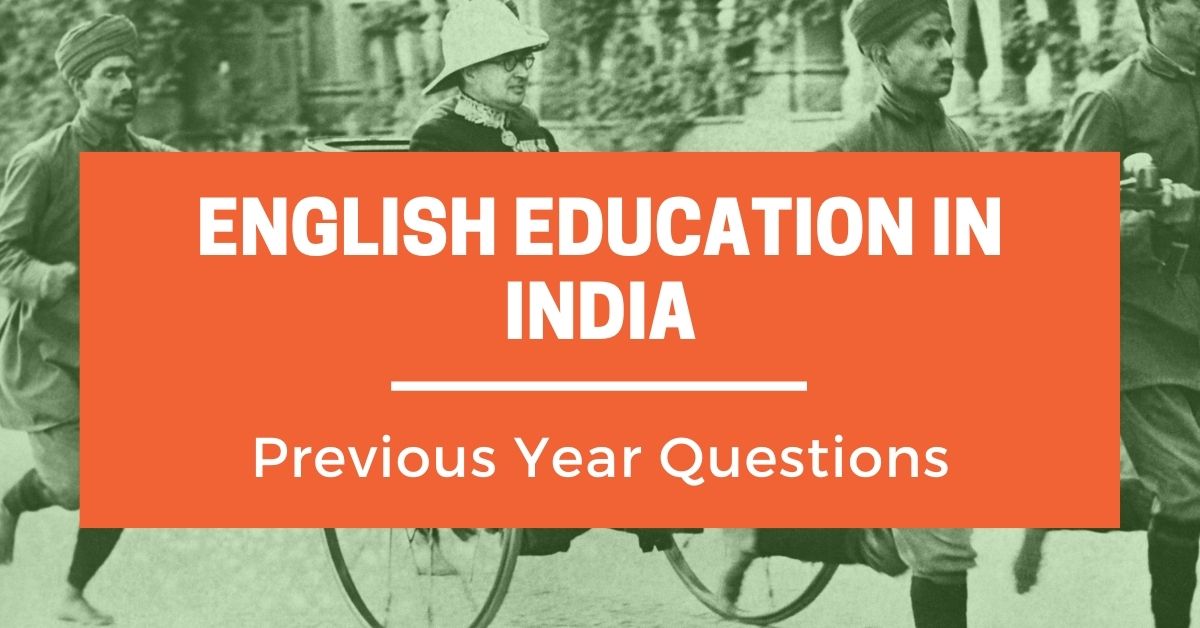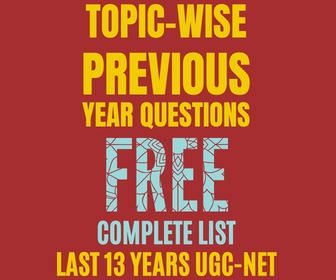UPDATE: Now, you can get these 3000+ questions in booklet/hardcopy format. Click here to know more.
Thomas Babington Macaulay, the writer of the infamous Minute of 1835, finds a mention in Salman Rushdie’s
(A) Midnight’s Children
(B) Shame
(C) The Moor’s Last Sigh
(D) Fury
Ans: (C)
Which of the following two points Were emphasised by ‘Wood’s Despatch of 1854’?
(a) Teaching of the English language along with the study of vernacular language
(b) Compulsory inclusion of Christianity in the curriculum
(c) The gradual Withdrawal of government patronage from Indian languages
(d) The importance of female education
Choose the correct option :
(A) (a) and (d)
(B) (a) and (b)
(C) (a) and (c)
(D) (b) and (c)
Ans: (A)
Which British administrator passed a resolution for the “Promotion of European literaters and science among the natives of India”?
(A) Lord Hastings
(B) Lord Cornwallis
(C) Lord Bentinck
(D) Lord hardinage
Ans: (C)
To whom did Raja Ram Mohan Roy write in 1823 his letter seeking the introduction of English education in India ?
(A) Lord Amherst
(B) Lord Bentinck
(C) Lord Cunningham
(D) Lord Hastings
Ans: (A)
Match the author with the text:
a) Rita Kothari
b) Probal Dashupta
c) Braj b. Kachru
d) Baljinder k. mahl
i. The queen’s hinglish
ii. The indianization of English
iii. Translating India
iv. The otherness of English
Choose the correct option:
(A) (a)-(iv), (b)-(iii), (c)-(i), (d)-(ii)
(B) (a)-(iii), (b)-(iv), (c)-(ii), (d)-(i)
(C) (a)-(iv), (b)-(ii), (c)-(i), (d)-(iii)
(D) (a)-(iii), (b)-(i), (c)-(ii), (d)-(iv)
Ans: (B)
An Indian English poet once remarked that his discipline and education gave him his “outer” whereas his Indian origin gave him “inner” form. Reflecting a part of this claim is a famous essay he called .
(A) ”Is There a Native Way of Thinking ?”
(B)”Can the Subaltern Speak ?”
(C) ”Where Do We Go from Here : Some Speculations”
(D) ”Is There an Indian Way of Thinking ?”
Ans: (D)
Beginning 1996, an Indian publisher commenced the publication of a series of modern Indian novels in English translation. By 2003, it had published eighty novels of repute from almost all Indian languages. Identify the publisher.
(A) Asia Publishing House
(B) Macmillan India
(C) Jaico
(D) Arnold Heinemann
Ans: (B)
Identify the two Indian texts translated by the Orientalist William Jones
I. Abhignanamshakuntalam
II. Katha Sarita Sagar
III. Mahabharatha
IV. Manusmriti
The right combination according to the code is
(A) I and II
(B) II and III
(C) I and IV
(D) III and IV
Ans: (C)
Which 19th century novelist expressed a wish to “exterminate the race” of Indians following the 1857 Mutiny in India ?
(A) William Makepeace Thackeray
(B) Charles Dickens
(C) George Eliot
(D) Anthony Trollope
Ans: (B)
After independence, although English was not an Indian language, it was accorded the status of an :
(A) Additional language
(B) Ancilliary language
(C) Associate language
(D) Administrative language
Ans: (C)
Who among the following has elaborated on the “Indianisation” of English?
(A) L.M. Khubchandani
(B) B. Kumaravadivelu
(C) B.B. Kachru
(D) Rajendra Singh
Ans: (C)
Which of the following is the most accurate description of Butler English ?
(A) A dialect of English spoken by the descendants of Anglo-Indians.
(B) A pidgin, also called “Kitchen English” spoken by South Asians in Europe.
(C) A minimal pidgin that emerged during colonial times in the Madras Presidency
(D) Any non-grammatical variety of English used by menials in Commonwealth countries.
Ans: (C)
Braj Kachru has observed a tendency among Indian-English speakers and writers to use hybridized lexical items. One example of this is
(A) Jugarh
(B) Ping-pong
(C) Chaywallah
(D) Lathi-charge
Ans: (D)
Which two titles from among the following deal with issues related to the institutionalisation of English in post-independence India?
(a) Provocations
(b) Professing Literature
(c) The Lie of the Land
(d) The Muse Unchained
The right combination according to the code is
(A) (a) and (d)
(B) (a) and (c)
(C) (b) and (c)
(D) (c) and (d)
Ans: (B)
Which of the following propositions refers to the recommendations of Charles Grant?
(A) The introduction of English as the medium of instruction in an Indian system of education that included literature, art and craft
(B) The introduction of English as the medium of instruction from lower levels in a few states as an experiment
(C) The introduction of English as the medium of instruction in a Western system of education that included literature, natural sciences and mechanical inventions
(D) The introduction of English as the medium of instruction in regional medium institutions that included only literature
Ans: (C)
The Sadler Commission Report (1917—1919) was critical of the quality of students graduating harm the university and had very perceptive remarks on English and the use of mother tongue in Indian education. What was this Commission appointed for?
(A) To examine the functioning of the Directorate of Public Instruction in Delhi
(B) To study the problems of Calcutta University
(C) To investigate and recommend teaching methods of languages generally
(D) To evolve a three-language formula for the Indian schools
Ans: (B)
Who are the co-editors of Chutneyfying English: The Phenomenon of Hinglish?
(A) Jamuna Kachru
(B) Rita Kothari
(C) Rupert Snell
(D) Alastair Pennycook
Ans: (C)
Macaulay’s Minute of 1835 sought to:
A. promote European literature and science among the natives.
B. impart knowledge of English literature and science through translated texts.
C. encourage branches of native learning by more useful studies.
D. stop expenditure on the publication of oriental works and spend funds only on English education.
Choose the correct answer from the options given below:
a) A and D only
b) B and D only
c) A and C only
d) B and C only
Ans: (a)
Which British administrator sought to make everything as English as possible in a country which resembles England in nothing”, as recorded by Sir Thomas Munro?
(A) Lord Bentick
(B) Lord Hastings
(C) Lord Cornwallis
(D) Lord Wellesley
Ans: (C)
On December 11, 1823, Rammohan Roy addressed a letter to the British authority which pleaded for modern western education and is considered historically important for the introduction of English education in India. Who was the letter addressed to?
(A) Lord Amherst
(B) Lord Minto
(C) Lord Macaulay
(D) Lord Bentick
Ans: (A)
Given below are two statements:
Statement I: The Orientalists in British India were not sympathetic towards India’s ancient learning.
Statement II: William Jones thought that in “imagination”, “ratiocination’, and philosophy, Indians were by no means inferior to Europeans.
In light of the above statements, choose the correct answer from the options given below
(A) Both Statement I and Statement II are true
(B) Both Statement I and Statement II are false
(C) Statement I is correct but Statement II is false
(D) Statement I is incorrect but Statement II is true
Ans: (D)
“Hari wrote a poem on the mountains-. Which two of the following are admissible statements about the above sentence?
A. The sentence is an example of lexical ambiguity.
B. The sentence is an example of structural ambiguity.
C. The sentence involves two deep structures.
D. The sentence involves two surface structures.
Choose the correct answer from the options given below:
a) A and B only
b) B and C only
c) 8 and D only
d) C and D only
Ans: (b)
Which one of the following best explains the term ‘paralanguage?
(A) The ways in which people mask what they mean by the words they use
(B) The ways in which people show what they mean other than by the words they use
(C) The ways in which words carry meanings unintended by the speaker
(D) The ways in which the silence underlying speech communicates wrong meanings
Ans: (B)
Assertion A: The introduction of English in India was primarily for the benefit and consolidation of British power.
Reason R: English catered to the social and economic aspirations of the emerging middle class and urban elites in India.
In light of the above statements, choose the correct answer from the options given below
a) Both A and R are true and R is the correct explanation of A
b) Both A and R are true but R is NOT the correct explanation of A
c) A is true but R is false
d) A is false but R is true
Ans: (b)
Who among the following was the first Director of the Central Institute of English and Foreign Languages, Hyderabad (now EFL University)?
(A) Prof V.K. Gokak
(B) Prof C.D. Narasimhaiah
(C) Prof C.J. Daswani
(D) Prof K. R. S. lyengar
Ans: (A)
Match List I and List II
List I
Word Borrowed
A. mongoose
B. loot
C. curry
D. betel
List II
Source Indian Language
I. Tamil
II. Malayalam
III. Hindu/ Urdu
IV. Marathi
Choose the correct answer from the options given below:
a) A – IV, B – III, C – I, D – II
b) A – IV, B – II, C – I, D – III
c) A – II, B – III, C – IV, D – I
d) A – II, B – I, C – IV, D – III
Ans: (a)



